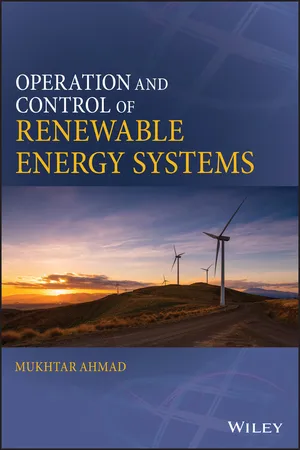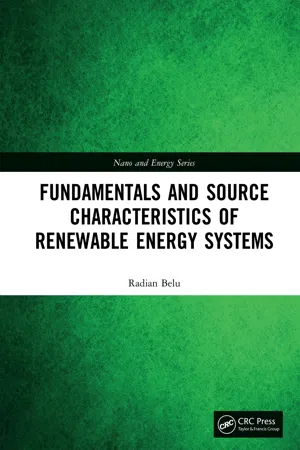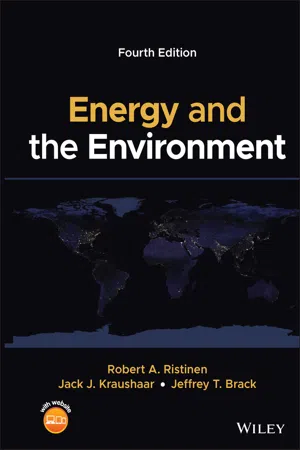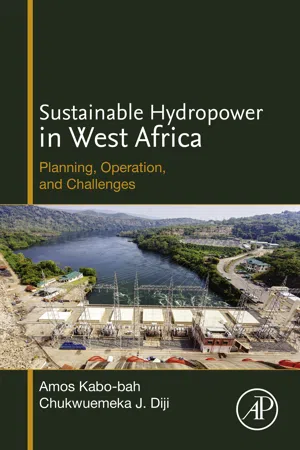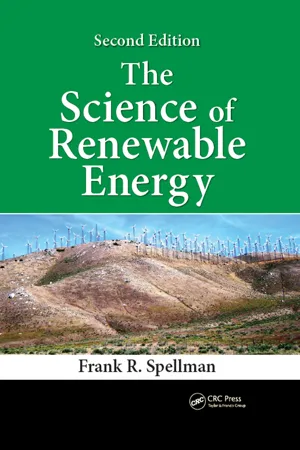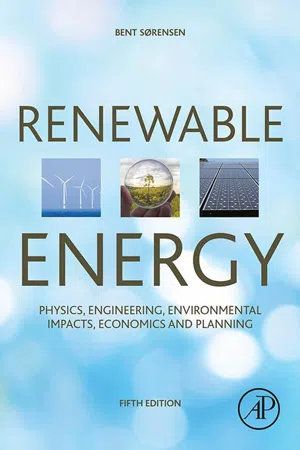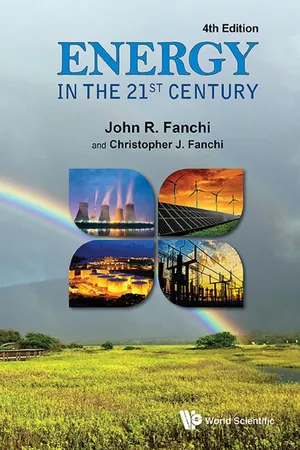Geography
Solar Power
Solar power refers to the conversion of sunlight into electricity using photovoltaic cells or solar thermal systems. It is a renewable energy source that is harnessed through solar panels, which capture the sun's energy and convert it into usable electricity. Solar power is a sustainable and environmentally friendly alternative to traditional fossil fuels, contributing to efforts to reduce carbon emissions and combat climate change.
Written by Perlego with AI-assistance
Related key terms
Related key terms
1 of 4
Related key terms
1 of 3
10 Key excerpts on "Solar Power"
- eBook - ePub
Energy for Sustainable Society
From Resources to Users
- Oguz A. Soysal, Hilkat S. Soysal(Authors)
- 2020(Publication Date)
- Wiley(Publisher)
2011 ), the total global solar potential is estimated between 1,575 and 49,837 exajoules (EJ) which is well above the current primary energy supply of 576 EJ worldwide reported by International Energy Agency (IEA 2018a).The estimated amounts reflect the availability of solar energy as a primary resource; thus, they do not consider the limitation and efficiency of solar conversion technologies, nor technical issues regarding the integration of solar electric generation to the interconnected grid. The minimum and maximum limits are based on the assumptions of the land available for solar generation.5.6.2 End‐use of Solar Energy
End‐uses of solar energy include heating, lighting, and electric generation. Passive solar technologies use natural sunlight without any energy conversion element or system. Active solar technologies convert solar irradiance into heat or electricity for transfer to a point of use.Source: © 2017 The World Bank. Solar resource data: Solargis; Black and white rendering; Soysal.Direct normal irradiation (DNI) and global horizontal irradiation (GHI) maps. These maps are published in color by the World Bank Group, funded by ESMAP, and prepared by Solargis. For more information and terms of use please visit http://globalsolaratlas.info .Figure 5.6Estimated annual solar potential.Figure 5.7Source: UNDP (2000 , p. 174, Table 5.19).5.6.2.1 Passive Solar Buildings
All buildings benefit of the sun for natural interior lighting. Sunlight reduces the cost of artificial heating in cold climates and winter. In contrast, in the summer excessive sunlight entering the buildings is less desirable since it increases the indoor temperature. If the building has artificial ventilation and air conditioning, contribution of the sun to the interior temperature increases the energy consumption. Buildings designed with properly oriented large, high emissivity glass windows and efficiently insulated envelop are referred to as passive solar buildings. Such buildings are primarily heated by solar energy in winter, but they are designed to minimize the sunlight in summer. Solar energy potential for passive solar buildings depends on the climate of the location. - Mukhtar Ahmad(Author)
- 2017(Publication Date)
- Wiley(Publisher)
Chapter 5 Solar Energy Systems5.1 Sun as Source of Energy
Solar energy is available directly from the energy produced by the Sun and is used to produce electricity, heat and light in solar energy systems. The Sun gets its energy from the nuclear fusion occurring in its core by converting millions of tons of hydrogen into helium and converting the difference in mass into energy. The Sun is a sphere of diameter 1,400,000 km, and because of nuclear fusion in its core, its outer region comprises hot gases mostly hydrogen and helium and has a surface temperature of 600 K. These gases are confined to the Sun due to the gravitational forces acting on the Sun. At this temperature, the Sun radiates the heat and light which travels through space and reaches the Earth. The rate of energy radiated from the Sun is 3.8 × 1023 kW. The energy received by the Earth's atmosphere is at an annual average rate of about 1.3–1.4 kW/m2 . Out of this energy received, a fraction is reflected by the atmosphere to the space. Still it is estimated that the maximum influx at the Earth's surface is about 1 kW/m2 . This amount is so large that at present rate of consumption, the total energy received in 1 h is sufficient to provide energy to the whole world for 1 year. But the problem is that not all the energy received from the Sun can be effectively used because it is thinly spread. In addition, the amount of solar energy which can be used is limited by diurnal and geographic variations and weather conditions. The yearly average values of effective solar irradiation are different at different locations on the Earth. To convert solar energy into useful energy using solar equipment, the precise values of the quality and quantity of solar radiation at a specific location are required.5.2 Solar Radiations on Earth
The solar radiation reaching the Earth's surface varies because of weather conditions and changing position of the Sun. In 1 year, that is, in 365.25 days, the Earth rotates around the Sun in slightly elliptical orbit. This elliptical orbit has major and minor axes equal to and , respectively. The Earth also rotates along its polar axis from the North Pole to the South Pole in 24 h. The polar axis is inclined at 23.45° to the plane of elliptical orbit. Because of Earth's inclination, there is difference in energy absorption by the two hemispheres of the Earth and is responsible for seasonal variations in solar radiation. It is also responsible for variations in local temperatures, local weather and wind pattern. Due to different positions of the Earth around the Sun in a year, four different seasons are observed, namely winter, summer, spring and autumn. When the northern hemisphere is having winter, the southern hemisphere will be having summer. Thus, the solar radiation reaching different parts of the globe is different. The annual mean of the solar radiation reaching the Earth's surface is for the oceans and- eBook - ePub
- Bent Sorensen, Mukesh Doble, Michel Broussely, Preben Maegaard, Frano Barbir, Gianfranco Pistoia, Soteris Kalogirou, Truman Storvick, Paul Breeze, Galen J. Suppes, Nasir El Bassam, Dr. Semida Silveira, Shang-Tian Yang, Aldo Vieira da Rosa, Harsh K. Gupta, Sukanta Roy(Authors)
- 2008(Publication Date)
- Academic Press(Publisher)
Whatever its type, a Solar Power plant has a major weakness. It can only generate electricity when the sun is shining. During the night there is no sunlight and so no electricity. In order to circumvent this problem, a Solar Power station must either have some form of conventional fuel back-up, or it must incorporate energy storage. Solar cells are frequently coupled with rechargeable batteries in order to provide continuous power in remote locations. Solar thermal power plants can also be designed with heat storage systems which allow them to supply power in the absence of the sun.Solar Thermal Power Generation
The sun is a source of high-quality heat which can easily be exploited for power generation. This was recognised as early as 1907 when the first patent for a solar collector was granted in Germany to Dr W. Maier. The development of modern solar thermal power technology began in the 1970s and was finally proved in the late 1980s with a series of commercial solar thermal power plants in California.In spite of the success of these plants no further commercial plants have been built anywhere in the world. Research has continued, however, and interest accelerated at the beginning of the twenty-first century following renewed support from government and international agencies. It seems likely that several new projects will be built before the end of the first decade of the new century.Modern solar thermal research has concentrated on three different approaches to converting solar energy into electricity. All require sunlight to be collected and concentrated to provide a high-energy source. The first uses a parabolic trough-shaped mirror to focus the energy contained in sunlight onto an energy collector at the focus of the parabola. These parabolic trough solar units can be deployed in massive arrays to provide a large generating capacity.The second approach, called a solar tower , employs a solar energy collector mounted atop a large tower. A field of mirrors is used to direct sunlight onto the collector where the concentrated heat is used in a power generation system. Both this and the parabolic trough system can be used to build utility-sized power plants. The third system, usually called the solar dish - Radian Belu(Author)
- 2019(Publication Date)
- CRC Press(Publisher)
2Solar Energy Resources
2.1 Introduction, Astronomical Background
Solar energy is considered as one the most potential and techno-economically viable renewable energy sources for electricity generation. In addition, it is clean, plentiful, and sustainable energy sources with almost zero pollution during the system operation. The use of solar energy for energy generation or other applications is growing at a fast rate due to the technological improvements that makes photovoltaic and solar energy systems cheaper, more robust, and efficient resulting in reduction of the overall generation cost. There are still not fully answered questions regarding the nature of the Sun energy generation. However, this is not of critical importance for the solar radiation terrestrial users, more important being the amount of energy, its spectral and temporal distributions, and its daily and yearly variability. Solar energy system design relies on a solar radiation comprehensive assessment and analysis at a particular site or location. Although solar radiation data have been measured and recorded for many locations, they have to be analyzed, processed and interpreted before a sufficient accurate estimate of the available solar radiation for a project can be made. For these reasons, a large emphasis in the current research studies is on the development of the reliable and accurate solar resource assessment methods. Energy decision makers are required to make critical judgments with regard to the energy generation, distribution, demand, storage, and integration. Accurate knowledge of the present and future atmosphere states is vital in making these decisions. A major solar energy drawback represents unpredictable nature and weather dependence of the solar radiation, one of the difficult weather variables to predict. Moreover, the solar radiation variations often do not match with the time energy demand distribution. Topography, ground cover clouds and aerosols all affect solar energy prediction. Research experiments can be costly in terms of resources and computational effort. Site-specific time series solar resource information, along with associated weather data is essential to the successful solar energy system design and deployment. These systems generally must be installed close to the load that they are designed to serve; therefore reliable solar data must be available for the installation site. It is unlikely that any pre-existing measured data will be available for the system optimum sizing or for predicting its performances.- eBook - ePub
- Robert A. Ristinen, Jack J. Kraushaar, Jeffrey T. Brack(Authors)
- 2022(Publication Date)
- Wiley(Publisher)
Passive heating of buildings is generally not included in tabulations of solar energy usage because every building gains some solar energy through its windows, even those that are not directly south‐facing. Tabulating these gains has been difficult to do with sufficient accuracy. For this reason, among others, the actual importance of solar energy to the natural energy budget is understated in most accounts of energy sources.4.5 Solar Thermal Electric Power Generation
An obvious application of solar energy is the production of electric power by using the sun to boil water to steam, which then could be used to drive an electric generator. The equations developed in Chapter 3 concerning the efficiencies of heat engines are directly applicable; one simply uses the sun to supply the heat energy to produce a suitable temperature, Th , of the steam. A major problem in making use of a diffuse source of energy such as the sun is attaining the necessary high temperature of the working substance in order to achieve a reasonable Carnot efficiency. Except in special situations, this high temperature requirement means that solar collectors will have to be used that focus the energy falling on a relatively large area to a spot, or focus, much smaller in area. A number of different schemes have been proposed, and some are currently being used. We shall examine several of these approaches to gain an understanding of the main ideas involved and to assess the practicality of generating electric power in this way.We could also possibly make use of solar energy to generate electric power by utilizing the natural thermal gradients in the tropical oceans to drive immense heat engines, and we now commonly generate electricity from solar energy in the form of wind and in falling water. These somewhat specialized topics in solar energy are discussed in the following chapter, along with other alternative sources of energy.There are two general categories of proven solar‐thermal electric power generating devices. Both involve focusing the sunlight to attain high temperature. The first, often called the power tower, uses a large array of many reflectors to concentrate the light onto a single central receiver mounted on a tower within the array of reflectors. This results in a very high temperature at the receiver, producing a similarly high temperature of the working fluid that is circulated through the receiver to a heat engine, thus resulting in a high Carnot efficiency for converting solar energy to electricity. In a second general type of power system, many concentrating reflectors are also used, but each reflector focuses sunlight onto an individual receiver for that collector. The heated circulating fluid is then brought to a central location to drive a steam engine. The choice between the two systems is whether to use the reflected rays of the sun or a flow of heated fluid to bring the solar energy to the central site. - eBook - ePub
Sustainable Hydropower in West Africa
Planning, Operation, and Challenges
- Amos T. Kabo-Bah, Chukwuemeka J. Diji(Authors)
- 2018(Publication Date)
- Academic Press(Publisher)
Hermann et al., 2014 ).5.2 Geographic Potential
The geographic potential may be seen as an intermediate step toward calculating the technical potential of RE resource. The geographic potential takes into account areas that are suitable and usable for specific RE employment. Depending on the details of available geographic data, an appropriate set of exclusion criteria can be set to realistically estimate the available land area (e.g., exclusion of urban areas for large-scale wind power production, protected land, sloped areas, and water bodies) (Hermann et al., 2014 ).5.3 Technical Potential
The technical potential is the geographic potential minus the losses from conversion into secondary energies and constrained by the requirements related to large-scale installation (e.g., spacing factors representing spacing and servicing areas of Solar Power plants or wind turbines, as well as (grid-) transportation losses). Technological, structural, ecological, and legislative restrictions and requirements are accounted for. In other words, RE technical potential represents the achievable energy generation of a particular technology given system performance, topographic limitations, environmental, and land-use constraints (Hermann et al., 2014 ; Kearney et al., 2002 ).5.4 Economic Potential
Economic potential is the proportion of the technical potential that can be utilized economically. It takes into account costs and other socioeconomic factors (e.g., fuel and electricity prices, other opportunity costs, and land prices).5.5 Solar Photovoltaic (PV) and Concentrated Solar Power
Photovoltaic Solar Energy is nowadays a mature technology for production of electricity with low‑carbon emissions and for a wide range of applications. West Africa is located under Sunbelt (ECREEE, 2012 - eBook - ePub
- Frank R. Spellman(Author)
- 2016(Publication Date)
- CRC Press(Publisher)
It is fitting to begin our discussion of the various kinds of renewable energy with the sun—the medium-sized star that symbolizes life, power, strength, force, clarity, and, yes, energy. In 1931, not long before he died, the inventor Thomas Edison told his friends Henry Ford and Harvey Firestone, “I’d put my money on the sun and solar energy. What a source of power! I hope we don’t have to wait until oil and coal run out before we tackle that” (Newton, 1989). The sun nourishes our planet. Solar energy is a renewable resource because it is continuously supplied to the Earth by the sun. When we consider the sun and solar energy, we quickly realize that there is nothing new about renewable energy. The sun was the first energy source; it has been around for 4.5 billion years, as long as anything else we are familiar with. On Earth, without the sun there would be nothing—absolutely nothing, zilch. The old 5-5-5 rule sums up the essence of life on Earth: We can survive 5 minutes without oxygen, 5 days without water, and 5 weeks without food. Without the sun, though, the 5-5-5-rule has no validity. Without the sun, nothing related to life has validity. Without the sun, there is nothing: no air, no water, no food … no life. The sun, the ultimate energy source, provided light and heat to the first humans. During daylight, people searched for food. They hunted and gathered and probably stayed together for their safety. When nightfall arrived, we can only imagine that they huddled together for warmth and reassurance under the light of the stars and moon, waiting for the sun and its live-giving and life-sustaining light to return.Solar energy (a term used interchangeably with Solar Power) uses various technologies to take advantage of the power of the sun to produce energy (Figure 4.1 ). Solar energy is one of the best renewable energy sources available because it is one the cleanest sources of energy. Direct solar radiation absorbed in solar collectors can provide space heating and hot water. Passive solar can be used to enhance the solar energy used in buildings for space heating and lighting requirements. Solar energy can also be used to produce electricity, and this is the type of renewable energy that we focus on in this chapter. Radiant energy from the sun, in the form of photons, strikes the surface of the Earth with the average equivalent of about 168 kWh of energy (equal to 575,000 Btu thermal energy) per square foot per year; it varies, of course, with location, cloud cover, and orientation with the surface (Hanson, 2004). The question, then, becomes one of how much of this energy can be used by consumers in the United States. Table 4.1 shows the energy consumption by energy source for 2014; in that year, solar energy accounted for 0.307 quadrillion Btu, a figure that is expected to steadily increase, which should be reflected in later figures when they are released.FIGURE 4.1 - eBook - ePub
Non-Conventional Energy in North America
Current and Future Perspectives for Electricity Generation
- Jorge Morales Pedraza(Author)
- 2022(Publication Date)
- Elsevier(Publisher)
Chapter 3: Solar energy for electricity generation
Abstract
Solar energy is a clean energy source useful for electricity generation and heating in sunny countries. Solar Power is a costly energy source and cannot be considered efficient as other renewable energy sources, reaching between 18% and 30% efficiency.In the USA, solar park capacity installed in 2019 reached 264,504 MW. Solar electricity generation from solar parks provided a record of 743,177 GWh in 2018, almost 69% higher than the electricity produced in 2010 (440,677 GWh). It is important to stress that almost 90% of the increase in electricity generated in the USA during 2008–18 came from wind and solar energies. Solar Power provided about 2% (85.2 TWh) of the total US electricity generated in 2019 (4401.3 TWh).Canada has only 4.7% of the total solar PV capacity installed in the region in 2019 and has no CSP facilities in operation. Canada's major investment is in wind energy, and its main energy source is hydropower supplying over 60% of the country's electricity generation. The investment trend in Canada's solar energy is to decrease during the coming years.Keywords
Renewable energy; Clean energy; Greenhouse gases; Solar energy; Solar photovoltaic; Concentrated Solar Power; Solar parks; Efficiency; Global warning; Electricity generationIntroduction
Solar energy is a reliable source for providing clean energy to many countries worldwide, particularly those located in sunny areas. Although solar energy is still a costly energy source used for electricity generation in many countries compared to the use of other energy sources for the same purpose, particularly natural gas and oil, it is a fact that solar systems' cost has been decreasing significantly during the last decade. It is expected that this trend will continue for years to come making the use of solar energy more attractive for electricity generation for several countries all over the world. Experts predict that the price of solar electricity production will be comparable to other energy sources in the next decade (Delucchi and Jacobson, 2013 - eBook - ePub
Renewable Energy
Physics, Engineering, Environmental Impacts, Economics and Planning
- Bent Sorensen(Author)
- 2017(Publication Date)
- Academic Press(Publisher)
3Individual renewable energy sources
Abstract
Details characterizing each renewable energy source are presented. For direct solar energy, variability, wavelength spectra and atmospheric scattering, and other processes are discussed. For wind energy, formation and variability is discussed, as well as the distinction between wind velocity, energy, and power. Waterflows in rivers and ocean are discussed, including currents, waves, and tides. Photosynthesis and biological productivity is discussed, and so are a number of other energy flows, such as geothermal, nuclear, or those formed by thermal and salinity gradients.Keywords
Solar radiation variability; Wind power variability; Ocean currents; Hydropower; Wave power; Tidal power; Geothermal energy; Thermal gradients; Nuclear energy; Biological energy; Biomass productivity3.1 Direct solar energy
Assessment of the “magnitude” of solar radiation as an energy source will depend on the geographical location, including local conditions, such as cloudiness, turbidity, etc. In section 2.2.2 a number of features of the radiation flux at a horizontal plane are described, such as spectral distribution, direct and scattered parts, geographical variations, and dependence on time, from annual to diurnal variations at a given location. The seasonal variation in solar radiation on a horizontal plane is shown in Fig. 3.1 , corresponding to the annual average of Fig. 2.24 .Figure 3.1 Average short-wavelength solar radiation on a horizontal plane at the Earth’s surface (W m−2 ), for the months of January (a ), April (b ) and July (c ) of 1997 (NCEP-NCAR, 1998 ). (d ) Average short-wavelength solar radiation on a horizontal plane at the Earth’s surface (W m−2 ), for the month of October of 1997 (NCEP-NCAR, 1998 - eBook - ePub
- John R Fanchi, Christopher J Fanchi;;;(Authors)
- 2016(Publication Date)
- WSPC(Publisher)
Solar radiation may be converted to other forms of energy by several conversion processes. Thermal conversion relies on the absorption of solar energy to heat a cooler surface. Biological conversion of solar energy relies on photosynthesis, which is a process that uses light to synthesize biologically useful chemical compounds. Photovoltaic conversion generates electrical power by the generation of an electrical current as a result of the interaction of light photons with certain types of conducting materials. Wind power and ocean energy conversion rely on atmospheric pressure gradients and oceanic temperature gradients to generate electrical power. In this chapter we focus on thermal conversion and photovoltaic conversion of solar energy in three forms: passive, active, and electric. Passive and active solar energy are generally used for space conditioning, such as heating and cooling, while solar electric energy is used to generate electrical power. Each of these forms is discussed below.6.1SOURCE OF SOLAR ENERGY
Solar energy is energy emitted by a star. Figure 6-1 shows the anatomy of a star. The source of solar energy is nuclear fusion. The fusion process occurs in the core, or center, of the star. Energy released by the fusion process propagates away from the core by radiating from one atom to another in the radiation zone of the star. As the energy moves away from the core and passes through the radiation zone, it reaches the part of the star where the energy continues its journey towards the surface of the star as heat associated with thermal gradients. This part of the star is called the convection zone. The surface of the star, called the photosphere, emits light in the visible part of the electromagnetic spectrum. The photosphere is surrounded by an atmosphere of hot gases called the chromosphere.Figure 6-1. Cross-section of a StarThe amount of sunlight that reaches the earth depends on the motion of the earth around the sun (Figure 6-2 ). When viewed from earth, the sun appears to follow a path relative to distant, background stars as earth orbits the sum. This path is an ellipse and the ellipse lies in a geometric plane called the ecliptic plane. The orbit of the earth around the sun lies in a geometrical plane called the orbital plane. The line of intersection where the orbital plane passes through the ecliptic plane is the line of nodes. The ecliptic plane and the orbital plane are shown in Figure 6-2
Index pages curate the most relevant extracts from our library of academic textbooks. They’ve been created using an in-house natural language model (NLM), each adding context and meaning to key research topics.
Explore more topic indexes
Explore more topic indexes
1 of 6
Explore more topic indexes
1 of 4

